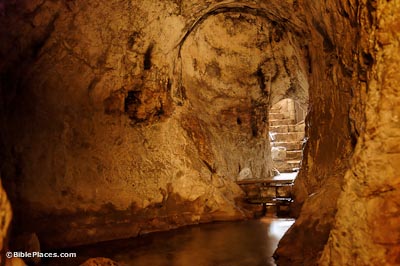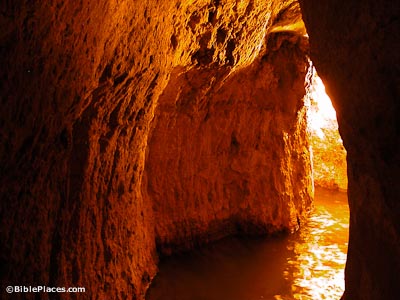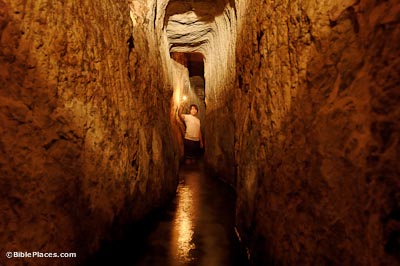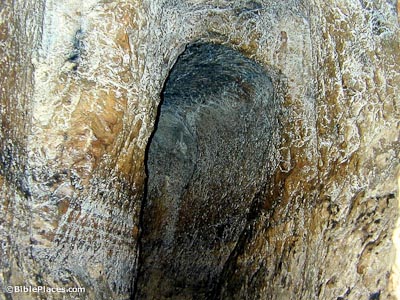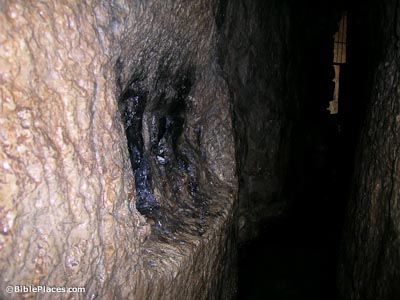The only spring in Jerusalem, the Gihon is a siphonic, karstic spring, and its name means “gushing”; it surges and the sound can be easily heard. It is estimated that the Gihon could have supported a population of about 2,500. The cave is a natural one, but it has been widened. Solomon was anointed at the Gihon Spring while his brother, Adonijah, was attempting to take the throne through a surreptitious coronation at En Rogel (1 Kgs 1).
Hezekiah's Tunnel
The Tunnel
A 1,750-foot (530-m) tunnel carved during the reign of Hezekiah to bring water from one side of the city to the other, Hezekiah’s Tunnel together with the 6th-century tunnel of Euphalios in Greece are considered the greatest works of water engineering technology in the pre-Classical period. Had it followed a straight line, the length would have been 1070 feet (330 m) or 40% shorter.
The Construction
Second Kings 20:20 (NIV): “As for the other events of Hezekiah’s reign, all his achievements and how he made the pool and the tunnel by which he brought water into the city…”
Second Chronicles 32:30 (NIV): “It was Hezekiah who blocked the upper outlet of the Gihon spring and channeled the water down to the west side of the City of David.”
The Meeting Point
Why is the tunnel S-shaped?
R. A. S. Macalister said the tunnel was a “pathetically helpless piece of engineering.”
Henry Sulley in 1929 first suggested that Hezekiah’s tunnel followed a natural crack in the rock.
Dan Gill argues that the two crews of diggers followed a natural karstic dissolution channel.
The Location of the Siloam Inscription
“[…when] (the tunnel) was driven through. And this was the way in which it was cut through: While […] (were) still […] axe(s), each man toward his fellow, and while there were still three cubits to be cut through, [there was heard] the voice of a man calling to his fellows, for there was an overlap in the rock on the right [and on the left]. And when the tunnel was driven through, the quarrymen hewed (the rock), each man toward his fellow, axe against axe; and the water flowed from the spring toward the reservoir for 1200 cubits, and the height of the rock above the head(s) of the quarrymen was 100 cubits.”

Download all of our Jerusalem photos!
$39.00 $49.99 FREE SHIPPING
Related Websites
Related BiblePlaces.com pages: Pool of Siloam, City of David, Warren’s Shaft. For historical images of water systems in Jerusalem, see Life in the Holy Land.
Hezekiah’s Tunnel (Jewish Virtual Library) Describes the circumstances for the carving of the tunnel in biblical times. Follow this by reading Siloam Inscription, which describes the finding of the inscription in modern times.
Hezekiah’s Tunnel Reexamined (Bible History Daily) This brief article gives a very nice introduction to the tunnel, assisted by several sketches and graphs.
Hezekiah’s Tunnel: An Engineering Marvel of Ancient Jerusalem (History Tools) While remaining quite readable, this article gives a fascinating look at the construction of Hezekiah’s Tunnel, and some of the complexities involved in it.
Hezekiah’s Tunnel (personal page) Includes photographs and a description of the author’s journey through the tunnel.
Siloam Inscription (personal page, K. C. Hanson) Gives a technical description of this ancient document and a translation of its text.
Gihon Spring (Engines of Our Ingenuity, University of Houston) Presents one explanation for the irregular design of the tunnel.
Hezekiah’s Tunnel (Zionism Dictionary) A historical description of the tunnel, discussing the biblical and historical context of this ancient marvel.
Siloam Inscription (Jewish Encyclopedia) This is an extensive article on the inscription, including sections titled “Description,” “The Work Described,” and “Date of the Work.”
Biblical Water Systems in Jerusalem (Jewish Virtual Library) Goes quite in-depth on the Warren’s Shaft system, the Siloam Channel, and Hezekiah’s Tunnel.
Rock-Cut Passage Above Virgin’s Fount (excerpt from Charles Wilson’s book titled The Recovery of Jerusalem) This is an interesting section on the discovery of the tunnel, from the original excavator. It dates to 1871. Pages 194–200 in both the original and the PDF.
Tunnel Engineering in the Iron Age: Geoarchaeology of the Siloam Tunnel, Jerusalem (Journal of Archaeological Science) Only the abstract is available online, but the interested can procure a copy of this 2006 article which would give a highly scientific perspective on the tunnel.
